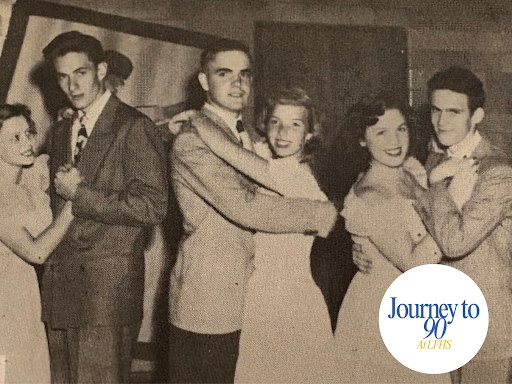In 2025, LFHS reached their 90th anniversary as a school. To reflect on all the memorable moments that have shaped LFHS both in the past and for years to come, The Forest Scout will feature a bi-weekly series highlighting significant events that occurred each school year. They will be shared in 10-year-increments, starting from its founding in 1935 and continuing to the present day! To kick things off, let’s take a look at the early years of LFHS: 1935-1944.
1935: Lake Forest High School is Founded.
It seems like an obvious choice for this year’s main event, but the history is surprisingly fascinating. In the early 1930s, the Great Depression plagued the United States. To provide jobs to millions of unemployed Americans, President Franklin D. Roosevelt created the Works Project Administration: they would build roads, bridges, and buildings for public use––including schools.
With a Federal Government grant of $1,342,140, LFHS was built during 1934-1935. When the school opened in the fall, there were 347 students enrolled and 21 faculty members. It was pretty small! The layout of the school was also different: the library was located in what’s now called the public room, and the cafeteria was on the third floor.
1936: A Year of Firsts.
Although counterintuitive, many of LFHS’s “firsts” occurred during its second year as an established school. The Forest Scout, which you’re reading right now, was founded in 1936 and has been publishing ever since! In addition, the LFHS National Honor Society chapter began.
While the Wall of Fame was introduced in 2005, its oldest member by age comes from the 1936 class. Alumnus General Richard A. Knobloch entered the military in 1940 as an aviation cadet. Once receiving his pilot wings in 1942, Knobloch flew in the US’s first air attack of Japan––the Doolittle Raid––and continued to fly for the US Air Force post-war. Later in his career, he served as the Deputy Chief of Staff of Plans of the Pacific Air Forces. Among many awards, he received the Air Force Distinguished Service Medal––given to those who have demonstrated exceptional military service.
1937: The First Championship. 
The first major championship ever won by LFHS was earned by the 1936-37 Boys Basketball Team. With a conference record of 10-1, the team led the Northwest Conference––despite it only being their second year participating.
As a bonus moment, the 1937 honor roll, posted in The Forest Scout, looks a lot different than the long, current honor roll. It was considered highly above-average to have a combination of As and Bs. We are overachievers!
1938: Alumni vs. Varsity Basketball Game.
Over winter break in 1938, alumni and current players duked it out in the school gymnasium for two games. In the first game, the current players took charge. Yet, during the second game, the same alumni who earned LFHS’s first conference championship soared ahead and won 47-29. What a cool event!
1939: The Forest Scout publishes an opinion article on World War Two.
In September 1939, World War Two began in Europe when Germany invaded Poland. Following these events, an editor for The Forest Scout argued that Americans should be more lenient with their judgement toward France and England.
“It is undeniable that these countries have committed many grave and serious mistakes,” wrote the editor. “Yet we should not be too quick to criticize those who are faced by such appalling problems and perils.”
The editor goes on to state potential strategies to end the war by Spring 1940. The war would conclude five years later, however––defining not only the world but also the experiences at LFHS during that time. Nonetheless, the author does end with a strong argument that proves itself to be true.
“The great fellow democracies must have trust and faith in each other, for unless we believe implicitly in democratic government it cannot survive the onslaught of dictatorship.”
1940: Senior Election Fraud.
In 1940, TFS writer Parker Wyman complained about the election fraud occurring on Student Council Election Day.
“While the elections were in progress, many candidates went around their sessions influencing others to vote for them by promising to return the favor…one of the purposes of the senior elections was to let those best suited for public office have this opportunity…” Wyman wrote.
It seems trivial, yet the merit of the Student Council was argued in a 1940 fall edition of The Forest Scout. This time, however, another writer asserted that the council was capable and effective.
“Our school has today one of the finest student councils ever to enter its portals during its six year history,” faculty member Mr. Moore said.
1941: The Rifle Club is Founded.
Organized by “rifle enthusiasts,” the Rifle Club hoped to obtain membership to the National Rifle association to gain access to US Army regulation .22 caliber rifles. Once they obtained the rifles, they fired them on a 50-foot-range behind the Southern end of the track.
1942: Time to Learn How to Fly!
Imagine picking out your electives for next year: ceramics, robotics, and flight training?! Yes, that’s right. In 1942, upperclassmen could enroll in a pre-flight training course and receive college credit for taking it. Both boys and girls could register, mirroring the new, joint efforts of men and women in the Air Force during World War Two. If you think driver’s education is scary, try taking this course!
 1943: Rations in the Cafeteria.
1943: Rations in the Cafeteria.
Today, nobody’s happy when the lunch room runs out of a certain meal, but can you picture having all of your meals rationed? To aid the war effort in 1943, this is exactly what happened in the LFHS cafeteria.
The school was allowed 60% of the processed and canned foods they previously bought and ate. This led to an increase of fresh vegetables on cafeteria trays, causing many student complaints. Moreover, the meat supply was reduced by 25%; to the dismay of students, this resulted in protein substitutes and meat stretchers like cheese and spaghetti––normal lunch foods today––being served.
1944: New Women’s Fashion Trends Shock School.
Many senior girls took their portraits earlier this week in the standard black top and nice necklace, often pearls. This traditional look was worn all the way back in 1944, except for a few daring fashionistas. A polka dot dress, pink jumper, and chunky accessories known as “junk jewelry” all were mentioned as standouts. If you weren’t that bold, it was all the rage to wear wide aluminum bracelets with names sketched on them.
Check The Forest Scout next week to learn about LFHS’s history during the post-war era!









Jocelyn/Laura • Sep 5, 2025 at 12:41 pm
Laura and I loved reading this article! So well written, I wonder who wrote it?